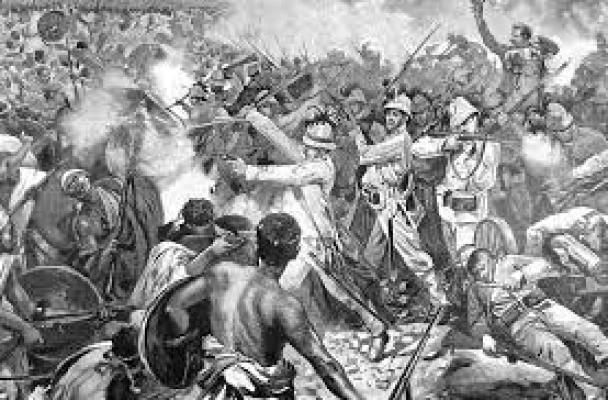Prince Owusu-ansah: A Life of...
November 13, 2025

The Battle of Amoaful, also known as the Sagrenti War was fought on January 31, 1874, was a decisive confrontation in the Third Anglo-Ashanti War, where the British sought to assert their dominance over the Ashanti Empire in West Africa. Led by Major-General Garnet Wolseley, the British forces faced significant resistance from the Ashanti, culminating in a bloody clash that left a lasting impact on the region.
The Black Watch, accompanied by the Rifle Brigade, played a crucial role in the battle. The British forces, with bagpipes playing "The Campbells Are Coming," charged with bayonets, catching the Ashantis off guard. While the British initially prevailed, slow-moving flanking columns in the jungle allowed the Ashantis to retaliate, attacking the British camp from the rear. Despite a subsequent small battle, the Battle of Ordashu, the British emerged victorious, opening the route to Kumasi.
Amankwatia, the Bantamahene and Ashanti war strategist, orchestrated the last stand at Amoaful against Wolseley's advancing forces. The battle, lasting around 24 hours, showcased the tactical prowess of the Ashanti forces. Although some British accounts attribute casualties to diseases like malaria and yellow fever, the Ashantis strategically used forest cover, ridges, and bogs to their advantage. Amankwatia's calculations, combining superior numbers with guerrilla warfare tactics, proved formidable against the technologically advanced British forces.
The capital, Kumasi, was abandoned by the Ashanti when the British arrived on February 4. The British occupied Kumasi briefly, demolishing the royal palace with explosives, leaving behind a smoldering ruin. The magnitude of the palace, housing extensive collections, including rows of books in multiple languages, impressed the British.
The Asantahene, ruler of the Ashanti, signed the Treaty of Fomena in July 1874, signaling the end of the war. The treaty, between Queen Victoria and King Kofi Karikari, outlined terms such as indemnity payments, an end to human sacrifice, and freedom of trade between Ashanti and British forts on the Gold Coast. Despite the British victory, the Ashanti maintained some autonomy.
Major-General Wolseley's swift campaign, lasting two months, brought about British success, leading to his promotion and honors. However, the Ashanti's hard-fought resistance, particularly at Amoaful, earned them respect from some British accounts. The use of a traction engine in active service marked a technological milestone.
Over 40 communities in the Amoaful Paramountcy, including Edwenase, Atemponya, and Beposo, became battlegrounds during the Sagrenti War. The war, with British soldiers crossing the Pra River, left a profound impact on the region, with communities struggling to rebuild even 150 years later.
The Battle of Amoaful remains a significant chapter in the history of the Ashanti-British conflicts, highlighting the resilience and strategic acumen of the Ashanti forces. The legacy of this battle and the Third Anglo-Ashanti War underscores the complex dynamics of colonial struggles and their enduring impact on the affected regions.
November 13, 2025
November 6, 2025
November 5, 2025
November 4, 2025
October 31, 2025
October 30, 2025
October 30, 2025
October 30, 2025
September 25, 2025
September 12, 2025